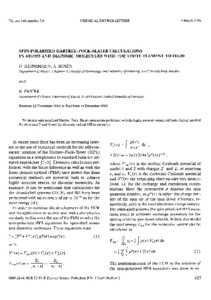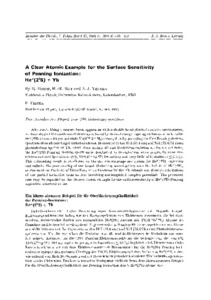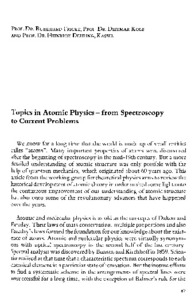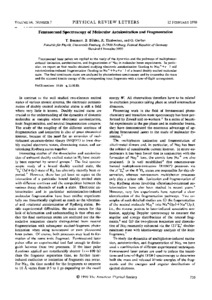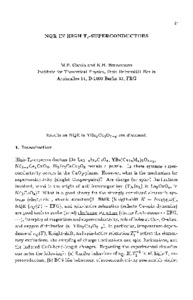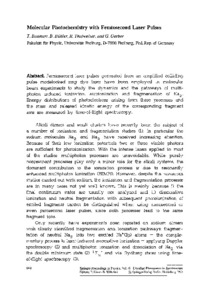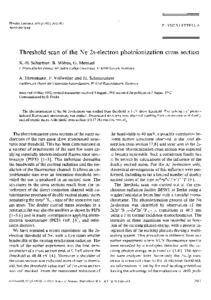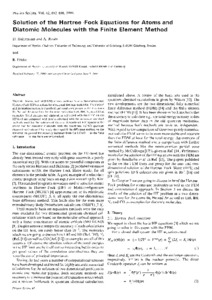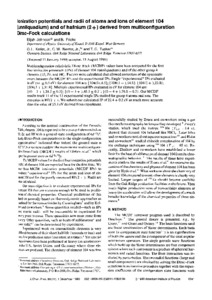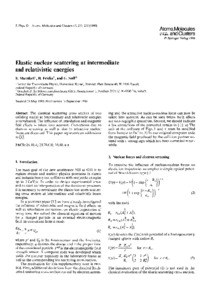Suche
Anzeige der Dokumente 1-10 von 11
Aufsatz
 Spin-polarized Hartree-Fock-Slater calculations in atoms and diatomic molecules with the finite element method
Spin-polarized Hartree-Fock-Slater calculations in atoms and diatomic molecules with the finite element method
(1990)
We present spin-polarized Hartree-Fock-Slater calculations performed with the highly accurate numerical finite element method for the atoms N and 0 and the diatomic radical OH as examples.
Aufsatz
 A clear atomic example for the surface sensitivity of penning ionization
A clear atomic example for the surface sensitivity of penning ionization
(1990)
Using a crossed-beam apparatus with a double hemispherical electron spectrometer,
we have studied the spectrum of electrons released in thermal energy ionizing collisions of metastable
He^*(2^3S) atoms with ground state Yb(4f^14 6s^2 ^1S_0) atoms, thereby providing the first Penning electron spectrum of an atomic target with-4f-electrons. In contrast to the HeI (58.4nm) and NeI (73.6/74.4nm)
photoelectron spectra of Yb, which show mainly 4f- and 6s-electron emission in about a 5:1 ratio, the He^*(2^3S) Penning ...
Aufsatz
 Femtosecond spectroscopy of molecular autoionization and fragmentation
Femtosecond spectroscopy of molecular autoionization and fragmentation
(1990)
Femtosecond laser pulses are applied to the study of the dynamics and the pathways of multiphoton-induced ionization, autoionization, and fragmentation of Na_2 in molecular-beam experiments. In particular,
we report on first results obtained studying electronic autoionization (leading to Na_2{^+} + {e ^-}) and
autoionization-induced fragmentation (leading to Na{^+} + Na + {e ^-}) of a bound doubly excited molecular state. The final continuum states are analyzed by photoelectron spectroscopy and by measuring the ...
Aufsatz
 Molecular photochemistry with femtosecond laser pulses
Molecular photochemistry with femtosecond laser pulses
(1990)
Femtosecond laser pulses generated from an amplified coiliding pulse modelocked ring dye laser have been employed in molecular beam experiments to study the dynamics and the pathways of multiphoton induced ionization, autoionization and fragmentation of Na2 . Energy distributions of photoelectrons arising from these processes and the mass and released kinetic energy of the corresponding fragment ions are measured by time-of-flight spectroscopy.
Aufsatz
 Threshold scan of the Ne 2s-electron photoionization cross edition
Threshold scan of the Ne 2s-electron photoionization cross edition
(1990)
The photoionization of the Ne 2s-electrons was studied from threshold to 1 eV above threshold. The technique of photon-induced fluorescence spectroscopy was applied. Pronounced structures were observed resulting from autoionization of doubly excited atomic states. A threshold cross section of 0.17 Mb was determined.
Aufsatz
 Solution of the Hartree-Fock equations for atoms and diatomic molecules with the finite element method
Solution of the Hartree-Fock equations for atoms and diatomic molecules with the finite element method
(1990)
The finite element method (FEM) is now developed to solve two-dimensional Hartree-Fock (HF) equations for atoms and diatomic molecules. The method and its implementation is described and results are presented for the atoms Be, Ne and Ar as well as the diatomic molecules LiH, BH, N_2 and CO as examples. Total energies and eigenvalues calculated with the FEM on the HF-level are compared with results obtained with the numerical standard methods used for the solution of the one dimensional HF equations for atoms and for ...
Aufsatz
 Ionization potentials and radii of atoms and ions of element 104 (unnilquadium) and of hafnium (2+) derived from multiconfiguration Dirac-Fock calculations
Ionization potentials and radii of atoms and ions of element 104 (unnilquadium) and of hafnium (2+) derived from multiconfiguration Dirac-Fock calculations
(1990)
Multiconfiguration relativistic Dirac-Fock (MCDF) values have been computed for the first four ionization potentials (IPs) of element 104 (unnilquadium) and of the other group 4 elements (Ti, Zr, and Hf). Factors were calculated that allowed correction of the systematic errors between the MCDF IPs and the experimental IPs. Single "experimental" IPs evaluated in eV (to ± 0.1 eV) for element 104 are: [104(0),6.5]; [104( 1 + ),14.8]; [104(2 + ),23.8]; [104(3 + ),31.9]. Multiple experimental IPs evaluated in eV for element ...
Aufsatz
 Elastic nuclear scattering at intermediate and relativistic energies
Elastic nuclear scattering at intermediate and relativistic energies
(1990)
The classical scattering cross section of two colliding nuclei at intermediate and relativistic energies is reevaluated. The influence of retardation and magnetic field effects is taken into account. Corrections due to electron screening as well as due to attractive nuclear forces are discussed. This paper represents an addendum to [l].

